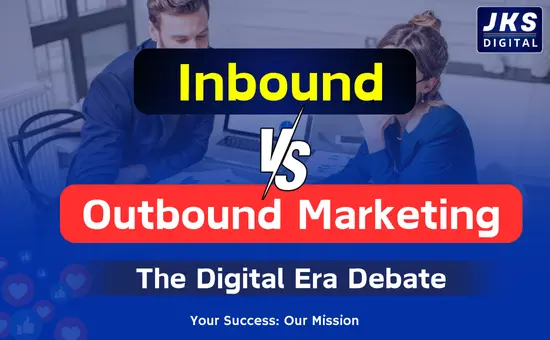Inbound vs Outbound Marketing: Marketing is the cornerstone of any business’s growth strategy, and in today’s digital landscape, two major approaches dominate the conversation: Inbound Marketing and Outbound Marketing. Both strategies aim to capture the attention of customers, but they do so in strikingly different ways. This article dives deep into the debate between these two methods, helping you understand which approach is better suited for your business in the digital era.

What is Inbound Marketing?
Inbound marketing focuses on attracting potential customers by offering valuable content and experiences tailored to their needs. Instead of interrupting the audience, inbound marketing seeks to draw them in through engaging and informative content.
Key Components of Inbound Marketing
- Content Marketing: Blogs, eBooks, videos, and webinars that address specific pain points.
- Search Engine Optimization (SEO): Optimizing content to rank higher on search engines.
- Social Media Engagement: Sharing valuable posts that spark conversations.
- Email Nurturing: Sending personalized emails to guide prospects through the buyer’s journey.
How Inbound Marketing Works
Inbound marketing operates like a magnet. It pulls prospects toward your business by aligning with their interests and solving their problems. For example:
- A blog post that addresses common enquiries about your industry.
- A printable handbook in return for your email address.
- Engaging social media campaigns that provide value rather than just promotions.
Read Also – How AR Advertising is Shaping the Future of Marketing
What is Outbound Marketing?
Outbound marketing is the traditional method of advertising, where businesses actively push their message out to a broad audience, often with the hope that some will respond.
Key Components of Outbound Marketing
- TV and Radio Ads: Broadcasting messages to large audiences.
- Cold Emails and Calls: Reaching out directly to potential customers.
- Display Ads: Online banners and pop-ups aimed at grabbing attention.
- Event Sponsorships: Promoting a brand through partnerships.
How Outbound Marketing Works
Outbound marketing operates like a megaphone. It broadcasts messages widely, relying on interruption to gain attention. For example:
- A TV commercial during prime time.
- Cold calls pitching a product to random prospects.
- Paid ads appearing on websites or social media.
Read Also – Unlocking Success in 2025: How to Stay Ahead as an Expert
Key Differences Between Inbound and Outbound Marketing
| Aspect | Inbound Marketing | Outbound Marketing |
|---|---|---|
| Approach | Pulls customers in with valuable content. | Pushes messages out to a wide audience. |
| Targeting | Focused on specific, relevant audiences. | Broad and less personalized. |
| Cost | Generally lower cost with long-term ROI. | Higher cost with short-term results. |
| Engagement | Two-way interaction with prospects. | One-way communication from brand to audience. |
| Goal | Build trust and nurture leads over time. | Immediate visibility and action. |
The Benefits of Each Approach
Why Choose Inbound Marketing?
- Sustainability: Creates long-term relationships with customers.
- Cost-Effective: SEO and content marketing often have a lower cost per lead.
- Engagement: Builds a loyal audience who willingly interacts with your brand.
Why Choose Outbound Marketing?
- Immediate Reach: Quickly spreads awareness about your product or service.
- Simplicity: Easier to set up campaigns, especially for new businesses.
- Broad Visibility: Ideal for mass-market products or services.
Which Approach is Better in the Digital Era?
The digital era has revolutionized how businesses interact with customers. Here’s how these two strategies fare:
Read Also – Performance Marketing vs Brand Marketing: A Comparative Guide
Inbound Marketing in the Digital Era
Inbound thrives in digital spaces where customers actively search for solutions. With tools like Google Analytics, social media insights, and email automation, it’s easier than ever to track the effectiveness of inbound campaigns.
For example:
- A small e-commerce business can leverage SEO to appear in search results for “affordable handmade jewelry.”
- A SaaS company can use email nurturing to educate users about its product features.
Outbound Marketing in the Digital Era
Despite its traditional roots, outbound marketing remains relevant in the digital age. Digital ads, sponsored posts, and programmatic advertising allow businesses to target specific demographics more effectively.
For instance:
- A new product launch can benefit from a well-targeted Facebook ad campaign.
- A local business can use Google Ads to be at the top of search results right away.
Should You Combine Both Strategies?
In the digital era, the best marketing strategies often combine the strengths of both inbound and outbound marketing. This is known as an integrated marketing strategy.
Why Combine?
- Greater Reach: Outbound marketing generates immediate visibility, while inbound nurtures long-term relationships.
- Balanced Budget: Outbound provides quick wins; inbound delivers lasting value.
- Improved ROI: A mix ensures that every touchpoint is optimized for engagement and conversion.
Read Also – Social Media vs SEO: Which Digital Marketing Strategy is Right for You?
Example of an Integrated Approach
- Use outbound ads to promote a free webinar (outbound).
- Offer valuable insights in the webinar and nurture attendees through email campaigns (inbound).
- Retarget attendees with social media ads for related products or services (outbound).
Final Thoughts
The debate between inbound and outbound marketing is less about which is better and more about how they fit into your overall strategy. While inbound marketing aligns with the modern consumer’s preference for value-driven interactions, outbound marketing can’t be ignored for its ability to create instant buzz and awareness.
Key Takeaway
For most businesses in the digital era, a hybrid approach that leverages the best of both worlds is the way forward. Focus on understanding your audience, experimenting with both strategies, and continuously optimizing based on results.
By mastering the art of combining inbound and outbound marketing, you can achieve greater success and establish your brand as a leader in your industry.




